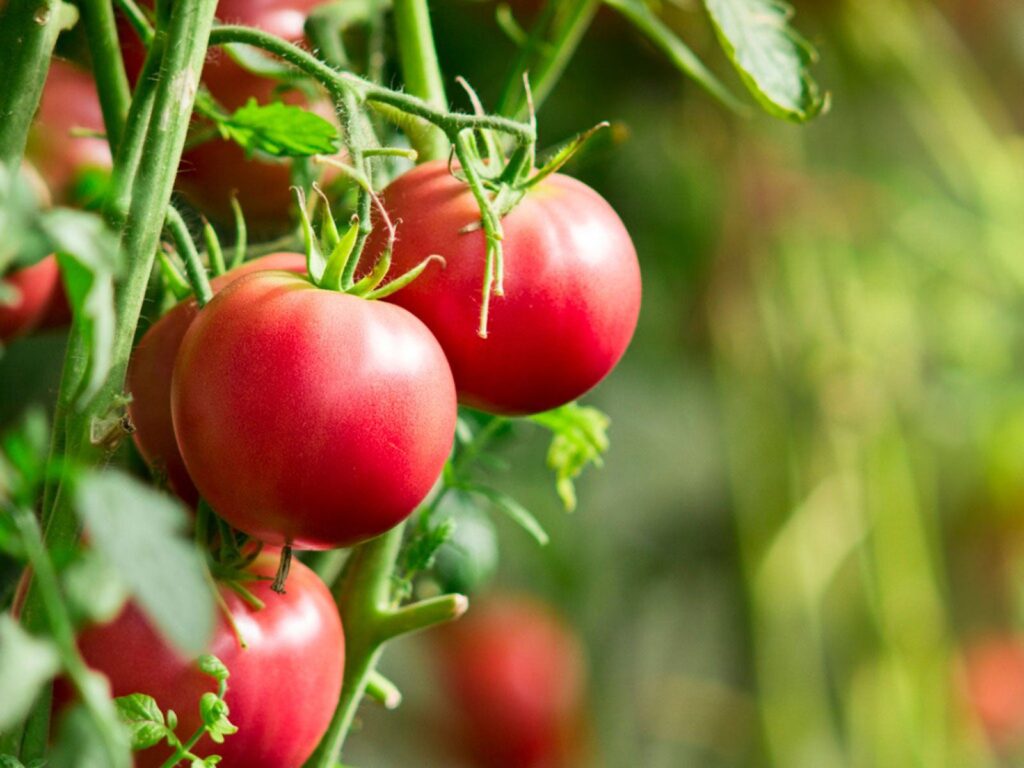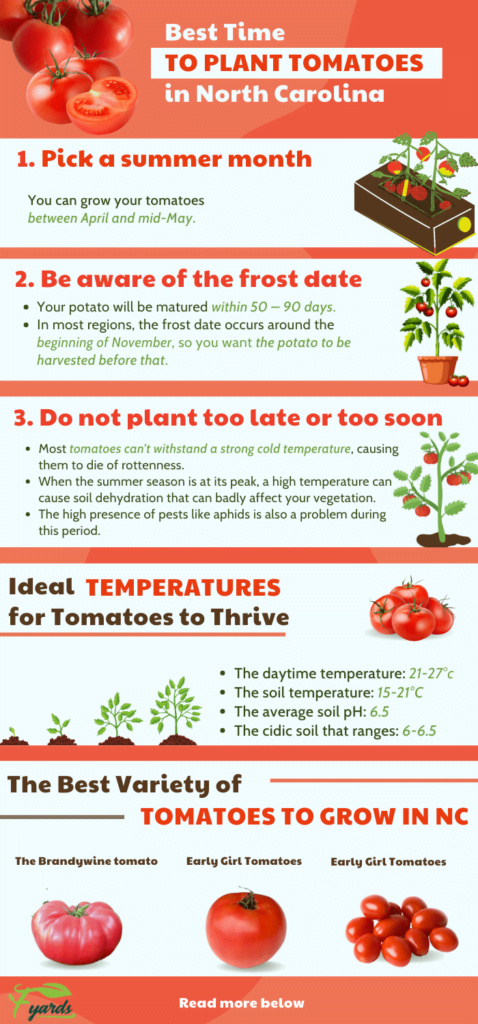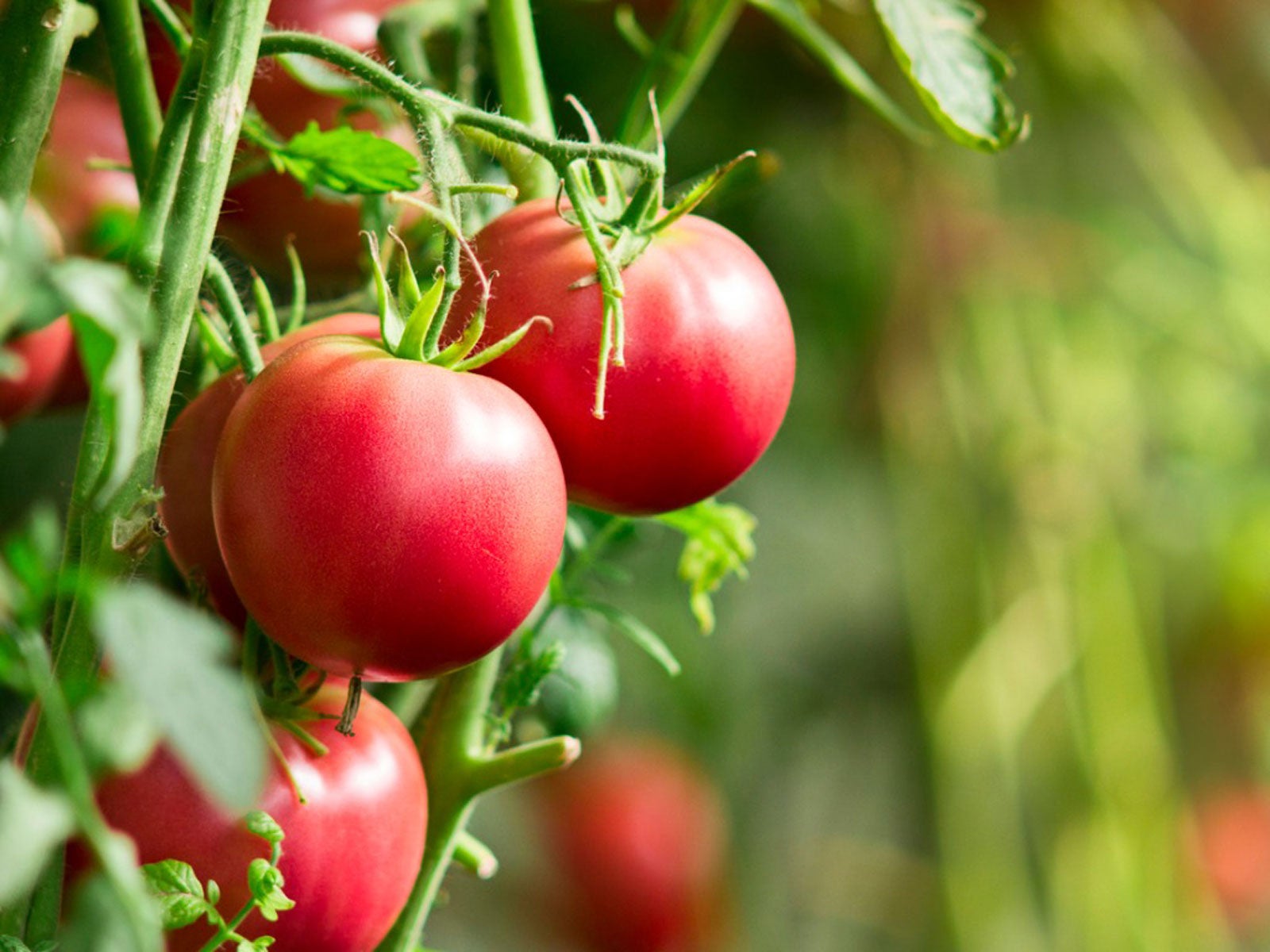Tomatoes, one of the most popular and versatile vegetables, are widely cultivated around the world. However, to ensure their optimal growth, it is crucial to understand the ideal temperature conditions for cultivating this delectable fruit. This article explores the question, “What temperature do tomatoes grow best in?” By examining the effects of temperature on tomato plants, we will discover the range of temperatures that contribute to their successful growth, allowing gardeners and farmers alike to maximize their tomato harvest.

Ideal Temperature for Tomato Growth
When it comes to tomato cultivation, temperature plays a crucial role in determining the success of the plants. Tomatoes thrive in specific temperature ranges, and understanding these optimal conditions is essential for maximizing yield and ensuring the overall health of the plants. In this article, we will explore the ideal temperature for tomato growth, the effects of temperature extremes on tomato plants, the importance of choosing the right tomato variety for your climate, temperature management techniques for tomato cultivation, the impact of temperature fluctuations on tomato growth, the advantages of growing tomatoes in controlled environments, the temperature requirements during different growth stages, the effects of temperature on tomato flavor and quality, and the role of seasonal shifts in tomato growth. By delving into these topics, we aim to provide a comprehensive understanding of the significance of temperature in tomato cultivation and offer practical insights for optimal temperature management.
Optimal Temperature Range
Tomatoes thrive in a specific temperature range, and deviations from this range can significantly impact their growth and development. The ideal temperature range for tomato growth generally falls between 71°F (22°C) and 75°F (24°C). Within this range, tomato plants exhibit optimal metabolic functionality and photosynthetic activity, allowing for efficient nutrient uptake and energy production. It is important to note that this temperature range serves as a general guideline, and variations can occur depending on the specific tomato variety and environmental conditions.
Temperature Requirements for Germination
The germination process is a critical stage in a tomato plant’s life cycle, and temperature plays a vital role in ensuring successful seed germination. For tomato seeds to germinate, they typically require temperatures between 60°F (15°C) and 85°F (30°C). However, the optimal temperature for the germination process is around 70°F (21°C). Maintaining appropriate temperature conditions during germination is crucial to ensure strong and healthy seedling development.
Ideal Growing Temperatures
While the optimal temperature range for tomato growth mentioned earlier is suitable for most stages of plant development, specific temperature requirements can vary throughout different growth stages. During the seedling stage, temperatures between 65°F (18°C) and 70°F (21°C) are ideal for promoting robust growth. For vegetative growth, temperatures between 70°F (21°C) and 75°F (24°C) are recommended. Finally, during the flowering and fruiting stage, temperatures ranging from 75°F (24°C) to 85°F (29°C) are favorable for efficient flower pollination and fruit set.

Cold Stress and Tomato Plants
Cold stress can pose significant challenges to tomato plants, often resulting in stunted growth, leaf discoloration, and reduced fruit production. Tomato plants are considered sensitive to cold temperatures, with their growth and development being severely affected when exposed to temperatures below 50°F (10°C). Frosts and freezing temperatures can cause irreversible damage to the plants, leading to wilting, tissue damage, and even death. It is crucial to protect tomato plants from cold stress by employing various techniques such as covering the plants with protective materials or relocating them to a warmer environment during periods of extreme cold.
Heat Stress and Tomato Plants
While tomatoes generally thrive in warm temperatures, excessive heat can also have detrimental effects on their growth and productivity. High temperatures can lead to heat stress in tomato plants, causing wilting, leaf curling, reduced fruit set, and sunscald. The critical threshold for heat stress in tomatoes is around 90°F (32°C). When exposed to temperatures exceeding this threshold for extended periods, tomato plants struggle with their metabolic processes and may not be able to absorb nutrients efficiently. Implementing shading techniques, providing adequate ventilation, and maintaining soil moisture can help mitigate heat stress and promote optimal tomato growth even in hot climates.
Determining Your Climate Zone
Choosing the right tomato variety for your climate is crucial for successful cultivation. To determine which varieties are best suited for your location, it is important to identify your climate zone. Climate zones are categorized based on temperature patterns and other climatic factors. Various organizations, such as the United States Department of Agriculture (USDA), provide climate zone maps that can help you ascertain which zone you fall into. By understanding your climate zone, you can narrow down your search for tomato varieties that will thrive in your specific environmental conditions.
Choosing Tomatoes for Cooler Climates
In cooler climates, selecting tomato varieties that are suitable for lower temperatures is essential for ensuring successful growth and fruit production. Some tomato varieties are bred specifically for cooler climates and exhibit traits such as early maturity and cold tolerance. These varieties can withstand lower temperatures, allowing for an extended growing season and increased yields. Examples of tomato varieties known for their suitability in cooler climates include ‘Sub-Arctic Plenty,’ ‘Oregon Spring,’ and ‘Siberian.’
Choosing Tomatoes for Warmer Climates
In warmer climates, heat-tolerant tomato varieties are the key to successful cultivation. These varieties are bred to withstand higher temperatures and are often characterized by thicker foliage and increased heat stress resistance. Some popular tomato varieties for warmer climates include ‘Solar Fire,’ ‘Heatwave II,’ and ‘Phoenix.’ By selecting heat-tolerant varieties, you can ensure that your tomato plants can thrive even in hot and humid conditions.
Controlling Temperature in Greenhouses
Greenhouses provide an excellent means of temperature control for tomato cultivation, allowing for extended growing seasons and protection from adverse weather conditions. To effectively manage temperature in greenhouses, various techniques can be employed. Ventilation, both natural and artificial, plays a crucial role in regulating temperature by facilitating air circulation. Additionally, shading materials can be utilized to reduce heat buildup during hot periods, while heating systems may be necessary to provide warmth during colder months. By implementing these temperature management techniques, greenhouse cultivators can create an optimal environment for tomato growth.
Protecting Tomatoes from Cold Temperatures
In regions prone to cold temperatures, it is crucial to protect tomato plants from frost and freezing conditions. Several strategies can be employed to safeguard the plants and ensure their survival during periods of extreme cold. For example, covering the plants with frost blankets or row covers can provide insulation and retain heat around the plants. Utilizing protective structures, such as cold frames or high tunnels, can create microclimates that shield the plants from harsh weather conditions. Furthermore, incorporating mulch around the base of the plants can help insulate the roots and prevent moisture loss. By implementing these protective measures, tomato growers can prevent cold-induced damage and maintain plant health and productivity.
Providing Shade and Cooling in Hot Climates
In hot climates, shading techniques are essential to prevent heat stress and ensure optimal tomato growth. Shading materials, such as shade cloth or overhead structures, can be used to reduce the amount of direct sunlight reaching the plants, thereby lowering the temperature and minimizing the risk of sunburn and heat stress. Additionally, providing adequate cooling and ventilation through fans or misting systems can help dissipate excess heat and maintain a comfortable temperature for the plants. These measures can aid in optimizing tomato growth in hot climates and mitigating the adverse effects of high temperatures.

Effects of Temperature Fluctuations on Tomato Growth
Temperature fluctuations can significantly impact tomato growth and productivity. Rapid changes in temperature, especially during critical growth stages, can lead to stress and yield losses. Fluctuations can disrupt metabolic processes, alter hormone balances, and affect nutrient uptake, resulting in stunted growth, delayed flowering, and reduced fruit set. Inconsistent temperature conditions can also make tomato plants more susceptible to pests and diseases. It is essential to strive for temperature stability and avoid large variations to ensure optimal tomato growth and minimize the risk of adverse effects.
Preventing Temperature Fluctuations in Growing Environments
Maintaining temperature stability is fundamental to successful tomato cultivation. Several strategies can be employed to prevent temperature fluctuations in growing environments. Firstly, choosing a suitable location for tomato cultivation, considering factors such as sun exposure and wind patterns, can provide a more stable growing environment. Additionally, insulating the growing area with materials such as mulch or row covers can help buffer temperature fluctuations. Monitoring and adjusting air circulation, humidity levels, and irrigation practices can further contribute to temperature stability. By adopting these proactive measures, growers can create a more controlled and favorable environment for optimal tomato growth.
Utilizing Controlled Environments
Growing tomatoes in controlled environments, such as indoor hydroponic systems or climate-controlled greenhouses, offers numerous advantages. Controlled environments allow growers to manipulate temperature, lighting, humidity, and other conditions to create optimal growth environments that maximize tomato yield and quality. These systems minimize the impact of external weather fluctuations, provide consistent and controlled temperature conditions, and reduce the risks associated with pests and diseases. Additionally, by providing a year-round growing season, controlled environments enable continuous tomato production, offering growers a competitive edge in the market.
Optimizing Temperature for Maximum Yield
In controlled environments, growers have the opportunity to fine-tune temperature conditions to optimize tomato yield. Research has shown that certain temperature ranges can positively influence flowering, fruit set, and overall yield. For instance, maintaining temperatures around 68°F (20°C) during the flowering stage can enhance pollination and fruit development. Additionally, maintaining temperatures between 75°F (24°C) and 85°F (29°C) during the fruiting stage can promote optimal fruit growth and quality. By carefully managing temperature conditions, growers can achieve higher yields and ensure the profitability of their tomato cultivation endeavors.

Reducing Disease Risks
In addition to maximizing yields, growing tomatoes in controlled environments helps reduce the risk of diseases that are often associated with temperature variations and adverse weather conditions. Many tomato diseases thrive in specific temperature ranges and can spread rapidly in outdoor environments. By creating a controlled and stable temperature environment, growers can limit the occurrence and severity of diseases such as late blight, powdery mildew, and bacterial spot. Furthermore, in controlled environments, growers have better control over humidity levels and can implement preventive measures such as proper air circulation, sterilization techniques, and careful monitoring to minimize disease risks.
Temperature needs for seedling stage
During the seedling stage, proper temperature management is crucial for the development of strong and healthy tomato plants. Maintaining temperatures between 65°F (18°C) and 70°F (21°C) is recommended during this stage. Adequate warmth promotes robust root development, encourages early growth, and minimizes the risk of damping-off disease. Providing consistent and optimal temperatures during the seedling stage sets a solid foundation for the subsequent growth and fruiting phases.
Temperature needs for vegetative growth stage
The vegetative growth stage is marked by rapid foliage development and the establishment of a strong framework for tomato plants. Maintaining temperatures between 70°F (21°C) and 75°F (24°C) during this stage is ideal for promoting vigorous growth. Adequate warmth allows for efficient photosynthesis, nutrient absorption, and overall metabolic processes. Optimal temperature conditions during the vegetative growth stage are essential for establishing healthy plants with robust foliage and an abundance of energy reserves.
Temperature needs for flowering and fruiting stage
The flowering and fruiting stage is a critical period in tomato cultivation, and temperature conditions greatly influence the success of fruit set and subsequent yield. During this stage, temperatures between 75°F (24°C) and 85°F (29°C) are considered ideal for optimal flower pollination and fruit development. Warmth during this phase enhances pollen viability, increases flower durability, and promotes efficient fertilization. By providing the right temperature conditions during the flowering and fruiting stage, growers can ensure consistent fruit production and high-quality tomato yield.
Temperature Influence on Sugar Levels
Temperature plays a significant role in determining the sugar levels and sweetness of tomatoes. Cooler temperatures, especially during the fruit ripening stage, can inhibit sugar accumulation and result in less sweet-tasting tomatoes. On the other hand, warmer temperatures, within the optimal range, can enhance sugar synthesis and lead to sweeter fruit. By managing temperature conditions during tomato growth and ripening phases, growers can influence the flavor profile of their produce and cater to consumer preferences.
Impact of Temperature on Acidity Levels
Alongside sugar levels, temperature also affects the acidity levels of tomatoes, ultimately influencing their taste profile. Cooler temperatures tend to enhance the retention of organic acids, resulting in more acidic tomatoes. Conversely, warmer temperatures can cause a decrease in acidity, leading to milder-tasting fruit. The balance between sugar and acidity is crucial in achieving a desirable flavor balance in tomatoes. By carefully managing temperature conditions, growers can manipulate the acid-to-sugar ratio and cultivate tomatoes that match consumer preferences.
Temperature’s Role in Flavor Development
Temperature influences not only sugar and acidity levels but also the overall flavor development of tomatoes. A combination of optimal temperature conditions and the plant’s genetic makeup can result in a well-rounded, complex flavor profile. Cooler temperatures often contribute to a more intense and tangy flavor, while warmer temperatures can yield sweeter and milder flavors. The interplay between temperature and flavor compounds, such as volatile organic compounds, is a fascinating aspect of tomato cultivation, and it highlights the importance of temperature management in producing tomatoes with exceptional flavor.
Tomato Growth Across Seasons
Tomatoes are known for their seasonal growth patterns, with different varieties exhibiting preferences for specific seasons. Understanding the seasonal growth characteristics of tomatoes is vital for adapting temperature management strategies accordingly. In regions with distinct seasons, tomato growth is typically aligned with warmer months, favoring spring and summer cultivation. However, by utilizing techniques such as greenhouse cultivation, hydroponics, or indoor gardening, growers can extend the tomato growing season and enjoy fresh produce year-round.
Adjusting Temperature in Different Seasons
With the knowledge of tomato growth patterns across seasons, growers can adjust temperature conditions accordingly to achieve optimal growth. During the warmer months of spring and summer, it is essential to manage temperature-related challenges such as heat stress. Employing shading techniques, ensuring proper ventilation, and implementing cooling measures can help maintain appropriate temperature levels during these seasons. Conversely, during cooler seasons, protection from frost and cold temperatures becomes a priority, necessitating the use of insulation materials and heating systems. By adapting temperature management practices to seasonal variations, growers can maximize tomato growth regardless of the external climate conditions.
Summary of Optimal Temperature Conditions
In summary, tomatoes grow best within an optimal temperature range of 71°F (22°C) to 75°F (24°C). This temperature range ensures efficient metabolic processes, photosynthesis, and nutrient uptake, leading to robust growth and high yields. Temperature extremes, such as cold stress and heat stress, can have detrimental effects on tomato plants, compromising their growth, and productivity. Choosing the right tomato variety for your climate zone is crucial for successful cultivation, as different varieties exhibit varying temperature requirements and tolerances. Temperature management techniques, such as controlling temperature in greenhouses, protecting tomatoes from cold temperatures, and providing shade and cooling in hot climates, are essential for creating optimal growing environments. Moreover, temperature fluctuations can negatively impact tomato growth, and preventive measures should be taken to maintain temperature stability. Growing tomatoes in controlled environments offers numerous advantages, including optimal temperature control, increased yield potential, and reduced disease risks. Temperature requirements also vary during different growth stages, and understanding these nuances is vital for providing the ideal conditions at each phase. Temperature influences tomato flavor and quality, with sugar levels, acidity, and overall flavor development being affected by temperature variations. Lastly, seasonal shifts in temperature and their impact on tomato growth highlight the need to adjust temperature management strategies accordingly. Overall, temperature management plays a critical role in tomato cultivation, and careful consideration of temperature conditions is necessary for optimal plant performance and successful crop production.
Importance of Temperature Management for Tomato Success
Temperature management is of utmost importance for the success of tomato cultivation. By understanding the ideal temperature conditions, the effects of temperature extremes, and the impact of temperature on various aspects of tomato growth and quality, growers can tailor their practices to maximize yield and ensure high-quality produce. Whether through temperature control in greenhouses, protective measures against cold or heat stress, utilization of controlled environments, or prevention of temperature fluctuations, proper temperature management is key to optimal tomato growth, disease prevention, and flavor development. By prioritizing temperature management, growers can unlock the full potential of their tomato crops and ensure long-term success in the industry.



